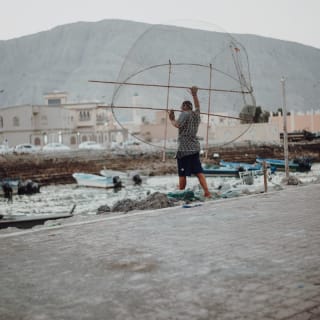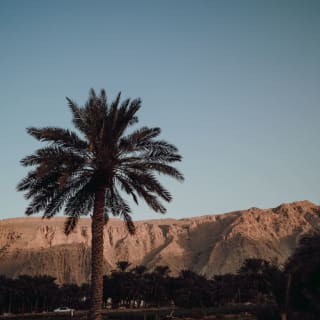
Witnesses of History
Oman's impressive fortresses tell tales of times long past, standing as symbols of the country's strategic importance over the centuries. These massive structures served as strongholds against invasions and as protection for trade routes, playing a central role in defending the Sultanate. However, they are not only witnesses to military strength but also expressions of Oman’s rich cultural and architectural traditions. Today, many of these historic fortresses have been restored and are open to visitors, offering a captivating glimpse into the country’s history and allowing travelers to step back in time.
Nizwa Fort: A Monument of Omani History
At the heart of Nizwa, one of Oman’s oldest and most important cities, stands Nizwa Fort, a towering symbol of political and military power. Located next to the traditional souk, it is one of the most famous fortresses in Oman, attracting thousands of visitors each year who come to admire its impressive architecture and fascinating history.
Historical Background
Built in the 17th century by Imam Sultan bin Saif Al Ya'rubi, Nizwa Fort stands as a symbol of the Sultanate’s power and resistance. Its construction took twelve years, and it played a pivotal role in driving the Portuguese out of Oman, making it a significant landmark in Omani independence. As the seat of the imams and a center of administration, the fort served not only military purposes but also played a role in governance during a time when Nizwa was a major hub for trade, religion, and politics.
Architectural Features
The fort’s most striking feature is its massive round tower, which rises 34 to 36 meters high with a diameter of 45 meters, dominating the city skyline. This central defensive structure housed 24 cannons, capable of repelling invaders through 480 gun ports. In addition to its thick mud-brick walls, the fort is equipped with intricate defense mechanisms like trapdoors, honey traps, and arrow slits. The fort is divided into two main sections: a palace used for residential and administrative purposes and a citadel built for defense.
Present-Day Significance for Visitors
Today, Nizwa Fort is one of Oman’s most visited attractions, offering deep insights into the country’s history and culture. The museum inside the fort features 20 galleries showcasing various aspects of Nizwa’s history, including traditional crafts, weaponry, and the region’s rich culture. A highlight for visitors is climbing to the top of the tower, where panoramic views of the city and surrounding mountains await. Guided tours and interactive exhibits bring history to life, while the fort’s garden and restored interiors offer an authentic experience.
Bahla Fort: A UNESCO World Heritage Site Steeped in History
Bahla Fort, majestically perched on a rocky hill at the edge of the Jebel Akhdar mountains, is one of Oman’s oldest and largest fortresses. It’s a symbol of Omani history and culture, offering an impressive view of the surrounding oasis. As the first site in Oman to be listed as a UNESCO World Heritage Site in 1987, it draws history buffs and culture enthusiasts alike.
Historical Background
Bahla Fort was built between the 12th and 15th centuries by the powerful Banu Nebhan tribe, who ruled the region during that time. Bahla was an important center for trade, religion, and politics, playing a key role in controlling the incense trade routes. The fort symbolizes the rich heritage of Ibadism, an Islamic branch widespread in Oman. The towering walls and turrets reflect the power and influence of the Banu Nebhan, who controlled the region until the 15th century.
Architectural Features
This fortress is an outstanding example of Islamic military architecture, built from mudbrick on a solid sandstone foundation. It comprises three main parts: Al-Qasabah, the oldest section dating back to the medieval period, and Bait al-Hadith and Bait Al-Jabal, added in the 17th and 18th centuries. A remarkable feature is the 13-kilometer-long wall that encircles both the fort and the surrounding oasis settlement. The sophisticated defense systems, including gun slits, "murder holes," and hidden escape routes, showcase advanced military strategies of the time. The interior is adorned with intricate stucco work, carved wooden beams, and Arabic inscriptions, making the fort an architectural masterpiece.
Present-Day Significance for Visitors
After extensive restoration, Bahla Fort was reopened to visitors in 2012. Today, it houses a museum with 20 galleries that display the cultural and historical heritage of the region. The watchtowers offer breathtaking panoramic views of Bahla and the surrounding oasis. Visitors can explore the restored living quarters, mosques, and underground storage rooms. Guided tours provide deep insights into the history and architecture of this significant fortress. Despite its grandeur, there is still room for improvement in visitor information, which is why many tourists opt for guided tours from Muscat.
Jabrin Fort: A Palace of Knowledge and Culture
Located in the heart of the Sultanate, Jabrin Fort stands as a prime example of Omani palace architecture. Unlike most of the country’s fortresses, which were built primarily for defense, Jabrin was constructed in 1675 by Imam Bil-Arab bin Sultan as a residence and center for learning. This unique fortress is a magnet for travelers looking to explore both the artistic architecture and the rich history of Oman.
Historical Background
Imam Bil-Arab bin Sultan built Jabrin Fort during a time of peace and prosperity. It served not only as a palace but also as a place for studying astrology, medicine, and Islamic law. The fort symbolizes the cultural renaissance of the 17th century, when science and the arts played a significant role in Omani life. Unlike many other Omani fortresses, Jabrin represents an era of intellectual development and cultural richness, marking a transition from military defense to scholarly pursuits.
Architectural Features
The three-story fort includes 55 rooms, such as magnificent reception halls, meeting rooms, a library, and classrooms. Particularly impressive are the ornate ceilings and wood carvings that highlight the beauty and elegance of the structure. The "Sun and Moon Hall," a reception room with 14 windows for optimal lighting, is one of the fort’s highlights. Additionally, a traditional falaj irrigation system runs through the fort’s walls, showcasing the thoughtful design of this palace.
Present-Day Significance for Visitors
Today, Jabrin Fort is one of Oman’s best-preserved historical buildings. Visitors can admire the stunning architectural details and take guided tours through the various rooms and courtyards. The beautifully painted wooden ceilings and the views from the towers offer breathtaking insights into Oman’s glorious history. A museum inside the fort highlights the cultural and scientific significance of the building, and visits to the date storage rooms and burial chambers make Jabrin an unforgettable experience for every traveler.
Al Jalali and Al Mirani Fortresses: Guardians of Muscat’s Harbor
The Al Jalali and Al Mirani fortresses are among Muscat’s most significant historical monuments, with a rich and eventful past. These impressive structures flank the entrance to Muscat’s harbor, playing a crucial role in the city's defense and standing today as symbols of Omani independence and maritime power.
Historical Background
Both fortresses were built by the Portuguese in the late 16th century: Al Jalali in 1586 and Al Mirani in 1588. They were constructed to defend Muscat’s harbor, a strategic target for attacks due to its location. The fortresses were built after a second Ottoman raid on the city, to secure Portuguese rule. In 1650, Omani forces led by Sultan bin Saif recaptured Al Jalali and Al Mirani, marking the end of Portuguese rule in Oman. This victory symbolized the beginning of Omani independence and the rise of the nation as a powerful seafaring state.
Architectural Features
These fortresses are stunning examples of Portuguese military architecture. Both are perched on steep cliffs overlooking Muscat’s harbor, offering breathtaking views of the city and the sea. Al Jalali consists of two massive towers connected by a wall with cannon slits, while Al Mirani features an intricate staircase carved into the rock. Both fortresses boast thick walls built to withstand cannon fire. Al Jalali is further enhanced by a central courtyard, gardens, and fountains added during its 1983 restoration.
Present-Day Significance for Visitors
Today, the Al Jalali and Al Mirani fortresses are major tourist attractions and landmarks of Muscat. Al Mirani was recently opened to visitors, offering panoramic views over the harbor and Al Alam Palace, along with a museum showcasing antique weapons and traditional art. Visitors can book guided tours to learn more about the fort’s history and its role in Muscat’s defense. Al Jalali, however, is accessible only by special permission and houses a private museum dedicated to Omani history. Both fortresses not only offer historical insights but also stand as symbols of Oman’s maritime and military heritage.
Oman's Fortresses – A Window into the Past
From the imposing Nizwa Fort at the heart of the country to the majestic twin fortresses of Al Jalali and Al Mirani guarding Muscat’s harbor, each of these fortresses tells its own story, reflecting Oman’s rich past. These featured fortresses, whether as centers of power like Nizwa or strategic defense points like Al Jalali and Al Mirani, bear witness to Oman’s fight for independence and its outstanding role as a trading and maritime power. Today, these monuments are not just historical landmarks but also vibrant museums, offering travelers deep insights into the history and culture of the country.
Discover Oman with experts who have called it their home
Your dream holiday, tailor-made by experts.
We don't just know Oman from books, we visit the country several times a year to experience the culture, landscape and people first-hand.
From your first enquiry to your return home, we are there for you personally - by phone, email or WhatsApp, whenever you need us. Our trips are as unique as you are: individually planned and provided with exclusive privileges and high-quality arrangements that will make your trip unforgettable.
Experts for your Oman trip







